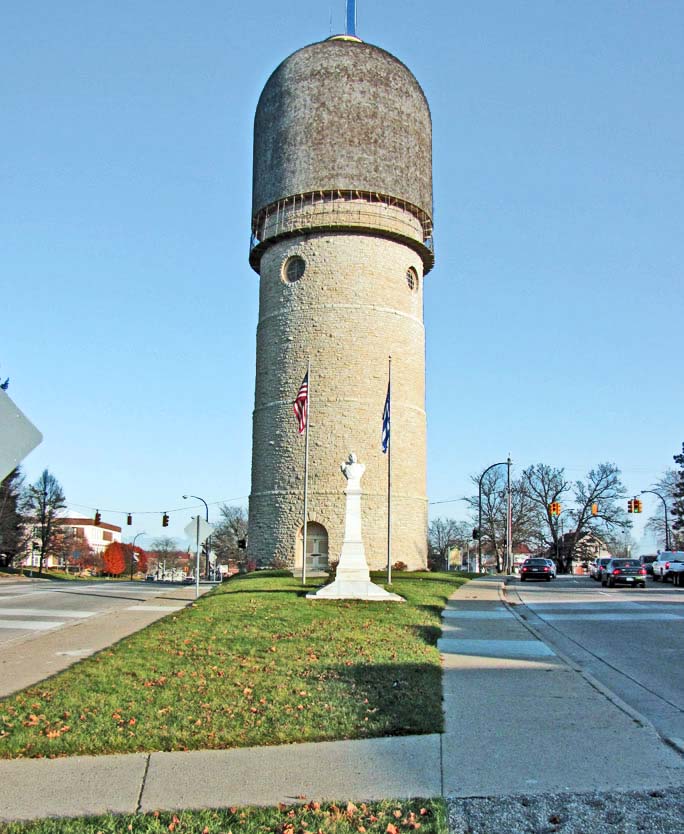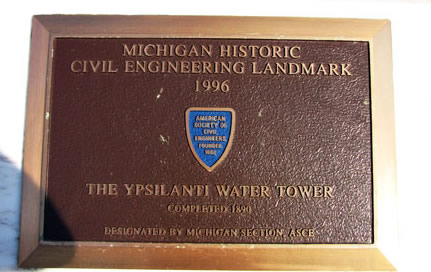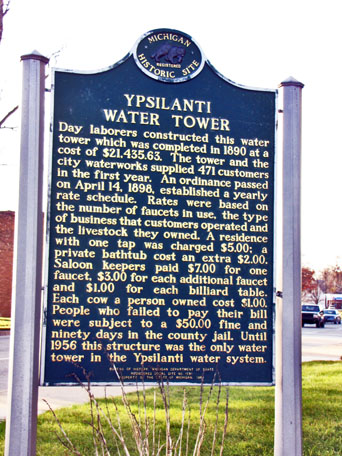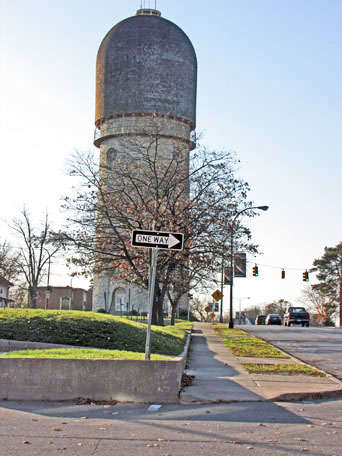

By 1888, the city of Ypsilanti realized they needed an excellent system for distributing water to the growing number of homes, manufacturing firms and commercial business. They appropriated $115,000 for a water works programs, including $21,000 to erect an efficient standpipe. They selected the highest point in the city for this facility and commissioned William R. Coats to design the impressive cylindrical structure that you see in the picture above. It is 147 feet in height and, at its base, has a circumference of 85 feet. It can hold 250,000 gallons of water. At the base that is just above ground level, the walls are 40 inches in width tapering to only 24 inches at the highest point.

Toward the top, you see that architect Coats added a dome for his tower and covered it with brown shingles. Above that dome there is a small cupola. Until the late 1950s, it was the city only water reservoir. The workers constructing this building apparently worried about their own safety so they involved Divine help by sculpting four crosses, including one Greek cross, on the exterior of this building, crosses that are still visible with very careful inspection.
At the base of this stand pipe, you will find an attractive statue of the hero of the Greek independence struggle for whom this city is named, Demetrius Ypsilanti.
This building has won more rewards and historical designations, I believe, than any other site or building in the Detroit area. In 1974, the American Water Works Association—the professional organization of those who ensure the flow of clean water to the residents of this nation—designed that Ypsilanti Standpipe as an American Water Works Landmark. There are only 11 other American Water Works Landmarks in the entire state: the Alpena Water Treatment Plant; Barton Dam in Ann Arbor; the Grosse Pointe Farms Water Treatment Plant; the Kalamazoo Water Tower; the Lake Superior Waterworks Swedetown Standpipe in Calumet; the Marine City Water Works; the Monroe Filtration Plant in Grand Rapids; the Monroe Water Works Filtration Plant in Monroe; the Mt. Clemens Water Filtration Plant, the Sault Ste Marie Water Storage Tank and the Water Works Filtration Plant in Detroit.
The Michigan Section of the American Society of Civil Engineers designed this building as a Michigan Historical Civil Engineering  Landmark. I do not know how many Michigan Historical Civil Engineering Landmarks are in Michigan. This building has not yet been ranked by the National American Society of Civil Engineers as a National Landmark for their organization. The only such national landmarks in Michigan designated by that professional organization are the Detroit-Windsor Automobile tunnel completed in 1930, the Sault Ste Marie Hydroelectric Complex finished in 1902; the Second Street Bridge in Allegan completed in 1886 and the St. Clair River Railroad Tunnel finished in 1891.
Landmark. I do not know how many Michigan Historical Civil Engineering Landmarks are in Michigan. This building has not yet been ranked by the National American Society of Civil Engineers as a National Landmark for their organization. The only such national landmarks in Michigan designated by that professional organization are the Detroit-Windsor Automobile tunnel completed in 1930, the Sault Ste Marie Hydroelectric Complex finished in 1902; the Second Street Bridge in Allegan completed in 1886 and the St. Clair River Railroad Tunnel finished in 1891.
The unusual architectural style of this building has drawn comment often. In 1913, apparently a group of Ypsilanti residents believed the style was too explicitly phallic. A commission was appointed to consider changes but no alterations were made. In 2003, Cabinet magazine—a magazine devoted to art and design—initiated a contest to determine the most phallic building in the world. Apparently a writer on their staff nominated the Williamsburg Savings Bank Building in Brooklyn as the global leader in that architectural category. That building, a 37-story Art Deco Byzantine Romanesque tower designed by Halsey, McCormack and Helmer has an interesting history and was, to some degree, designed as a phallic structure. Architect Helmer wanted the tower to have a flat and square top but the managers of the bank wanted to cap the tower with a dome. Helmer objected and realized how phallic his building would look, but the bank’s owners ordered the dome that still crowns this impressive building.
Readers—presumably from Washtenaw County—objected to the choice of the Brooklyn Bank. Some nominated the new Florida State Capitol in Tallassee while other suggested the new Torre Agbar—designed by Jean Nouvel and opened in 2005—in Barcelona. However, the editors of Cabinet selected the Ypsilanti Water Works Stand pipe as their winner.

Architect: William R. Coats
Construction material: Joliet Limestone
Date of completion: 1890
Date of reconstruction: 1974
Use in 2010: I believe this building is no longer used for the storage of water so it is a decorative
historic structure.
American Waterworks Association: The Ypsilanti Stand Pipe has been designated as an
American Water Landmark by this professional organization.
American Society of Civil Engineers: The Ypsilanti Stand Pipe has been designated by the Michigan Section of this organization as a Michigan Historic Civil Engineering Landmark.
State of Michigan Registry of Historic Sites: P24,962 Listed: September 21, 1988
State of Michigan Historical Marker: Erected: August 2, 1989
National Register of Historic Places: Listed October 26, 1981
Photograph: Ren Farley, November, 2009
Description prepared: February, 2009
Return to Michigan Civil Engineering Landmarks
Return to Home Page